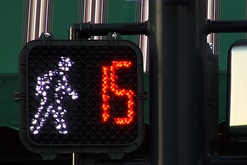Traffic Signals

The City’s traffic signals are timed with pedestrians in mind.
Whenever possible, signal cycle lengths are not more than 90 seconds at peak times and shorter at off-peak times, so that pedestrians and others do not have to wait too long. The average delay for pedestrians is not more than 40 seconds, and the City is committed to reducing the delay for pedestrians as much as possible. Shorter wait times mean that fewer pedestrians disobey the signals.
The City favors concurrent walk phases, where pedestrians cross at the same time as vehicles heading in the same direction. Concurrent phases mean much less waiting for pedestrians; studies show that people are generally not willing to wait for a short exclusive pedestrian phase, but cross with the parallel traffic even when they don’t have a walk signal. It is, therefore, usually safer to use concurrent signals, with a leading pedestrian interval (LPI) that gives pedestrians a head start on crossing so that they are well into the intersection before vehicles start to turn. Where there many turning vehicles, for example at T-shaped intersections, pedestrians have an exclusive crossing phase. Exclusive signals mean much longer waits and shorter crossing times for pedestrians, but sometimes they are unavoidable.
Countdown Signals
Countdown signals show pedestrians how many seconds they have before the light changes, which makes it easier for them to judge whether or not they have time to start crossing the street.
Push Buttons
Cambridge has eliminated most of its push-button pedestrian signals in favor of giving pedestrians a regular crossing time in the signal cycle. Except at mid-block crossings, push buttons often mean a long wait for pedestrians, and most people cross as soon as there is a gap in the traffic rather than waiting for their signal.
Audible Signals
These are installed in consultation with the Disabilities Commission.
For more information
For more information regarding traffic signals in Cambridge, contact the Environmental and Transportation Division at 617/349-4671.